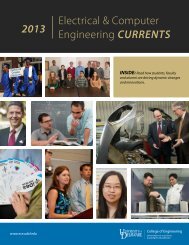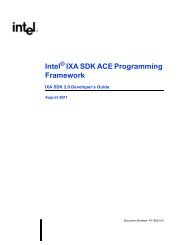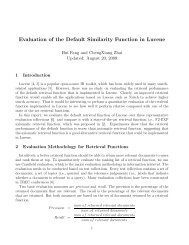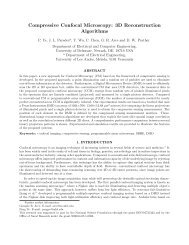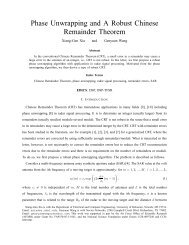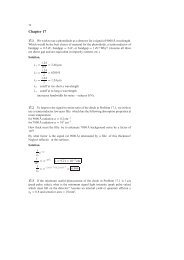- Page 1 and 2: HAND TRACKING, FINGER IDENTIFICATIO
- Page 3 and 4: Signed: Signed: Signed: Signed: Sig
- Page 5 and 6: Samuel Audet, for generously writin
- Page 7 and 8: 1.5 What is Not Covered : : : : : :
- Page 9 and 10: 3.3.2 Prediction of Contact Locatio
- Page 11 and 12: 4.5.4 The Optimization Search Loop
- Page 13 and 14: CONCLUSIONS : : : : : : : : : : : :
- Page 15 and 16: LIST OF FIGURES 1.1 Warped QWERTY k
- Page 17 and 18: 3.8 The correct segmentation for th
- Page 19 and 20: 4.12 Identity swaps which occurs af
- Page 21 and 22: 4.39 Palm cohesion factor versus th
- Page 23 and 24: LIST OF TABLES 1.1 Legend for nger
- Page 25 and 26: cubital tunnel syndrome Same as car
- Page 27 and 28: path In context of Chapters 3{5, th
- Page 29 and 30: ABSTRACT This research introduces m
- Page 31: Chapter 1 INTRODUCTION 1.1 The Stat
- Page 35 and 36: esponsiveness of the controls on a
- Page 37 and 38: without indentations to force the n
- Page 39 and 40: Table 1.1: Legend for nger combinat
- Page 41 and 42: Tapping these two ngers simultaneou
- Page 43 and 44: two nger chord moves the text curso
- Page 45 and 46: The proximity sensors measure the e
- Page 47 and 48: TYPING RECOGNIZER FINGER SYNCHRONIZ
- Page 49 and 50: hand position esti
- Page 51 and 52: extract independent translation, sc
- Page 53 and 54: the nger synchronization detector w
- Page 55 and 56: very important preventive measures
- Page 57 and 58: 1.6.2.5 Minimize user anticipation
- Page 59 and 60: extracted from hand</strong
- Page 61 and 62: language as they appear in communic
- Page 63 and 64: 2.1.5 Sensing Finger</stron
- Page 65 and 66: a) b) c) d) Figure 2.2: Projection
- Page 67 and 68: a) b) c) d) Figure 2.3: Ambiguities
- Page 69 and 70: few millimeters of the electrodes.
- Page 71 and 72: 41 Vertical Position on Surface (Y
- Page 73 and 74: 2.1.9 No Motion Blur on MTS Another
- Page 75 and 76: position is indicated by the amount
- Page 77 and 78: The o set-corrected image E is then
- Page 79 and 80: touches the surface and</st
- Page 81 and 82: 2.3.2 Properties of H<stron
- Page 83 and 84:
Vertical Position on Surface (Y axi
- Page 85 and 86:
Vertical Position on Surface (Y axi
- Page 87 and 88:
Vertical Position on Surface (Y axi
- Page 89 and 90:
Vertical Position on Surface (Y axi
- Page 91 and 92:
PATHS FROM PREVIOUS IMAGES HAND IDE
- Page 93 and 94:
3.2 Contact Segmentation The object
- Page 95 and 96:
CURRENT PROXIMITY IMAGE DIFFUSE CUR
- Page 97 and 98:
proximity signal Gz, orientation G
- Page 99 and 100:
guessed at. Since strict segmentati
- Page 101 and 102:
hand position at l
- Page 103 and 104:
A) B) Figure 3.4: Typical search pa
- Page 105 and 106:
with excluded electrodes in between
- Page 107 and 108:
threshold Kmaxima significance. Usi
- Page 109 and 110:
or Si�j[n]
- Page 111 and 112:
etween palm heels can be measured.
- Page 113 and 114:
3.2.8 Extracting Group Parameters T
- Page 115 and 116:
For convenience while distinguishin
- Page 117 and 118:
Note that usually each palm heel wi
- Page 119 and 120:
groups. Comparing the size of the p
- Page 121 and 122:
any alignment within a couple centi
- Page 123 and 124:
a) b) Figure 3.10: Unsmoothed a) <s
- Page 125 and 126:
a) b) Figure 3.12: Unsmoothed a) <s
- Page 127 and 128:
it can get to the index ngertip <st
- Page 129 and 130:
444 444 11 444 1111 222 33 44 1111
- Page 131 and 132:
STRICT SEGMENTATION REGION 22 111 2
- Page 133 and 134:
STRICT SEGMENTATION REGION 111 222
- Page 135 and 136:
or hand resting. T
- Page 137 and 138:
pairing method for marginal cases d
- Page 139 and 140:
Ppredy[n] = Py[n ; 1] + 4tPvy[n ; 1
- Page 141 and 142:
Pz[n] = Gz (3.36) P [n] = G (3.37)
- Page 143 and 144:
113 Vertical Position on Surface (Y
- Page 145 and 146:
of that contact's path by the path
- Page 147 and 148:
problem which must optimally match
- Page 149 and 150:
channels can still be reserved for
- Page 151 and 152:
to impose an ordering relation betw
- Page 153 and 154:
eliably identify all of a h
- Page 155 and 156:
or default hand po
- Page 157 and 158:
PATHS FROM PREVIOUS IMAGES HAND IDE
- Page 159 and 160:
when a hand is not
- Page 161 and 162:
4.3.1 Measuring Current H<s
- Page 163 and 164:
hand o set (Hmox[n
- Page 165 and 166:
eturns to default position. Alterna
- Page 167 and 168:
the estimated left hand</st
- Page 169 and 170:
START DEFINE IDENTITY ATTRACTORS AT
- Page 171 and 172:
Vertical Surface Position (cm) 12 1
- Page 173 and 174:
The optimization can then be stated
- Page 175 and 176:
solution techniques should be e cie
- Page 177 and 178:
4.4.4.4 The k-exchange Sequence The
- Page 179 and 180:
Pg o Pg o D D x x x x g' a Ab g' Aa
- Page 181 and 182:
g o h' x x a g' b g o h' x x a g' b
- Page 183 and 184:
This simple condition ensures that
- Page 185 and 186:
4.4.5.3 Summary of Swapping Behavio
- Page 187 and 188:
= jj ~agjj 4 +2jj ~agjj 2 jj ~ bhjj
- Page 189 and 190:
fairly gradual. Though the unsquare
- Page 191 and 192:
constrain one another within the ar
- Page 193 and 194:
A1 x F1 o A7 x x A2 D F2 o A3 x o A
- Page 195 and 196:
inter-contact angles in the same wa
- Page 197 and 198:
hand contact will
- Page 199 and 200:
With these weighted palm heel attra
- Page 201 and 202:
Vertical Position on Surface (cm) 1
- Page 203 and 204:
experimenter then adjusts the ampli
- Page 205 and 206:
4.4.6.6 Palm Heel Size Factor Palm
- Page 207 and 208:
palm separation factor quickly decr
- Page 209 and 210:
where cij is the weighted distance
- Page 211 and 212:
are compiled. These statistics prov
- Page 213 and 214:
183 pinch gesture, the thumb may st
- Page 215 and 216:
it would erroneously grow in respon
- Page 217 and 218:
Like the Voronoi cells of the assig
- Page 219 and 220:
shifting of assignments for h<stron
- Page 221 and 222:
Vertical Position on Surface (Y axi
- Page 223 and 224:
Vertical Position on Surface (Y axi
- Page 225 and 226:
Vertical Position on Surface (Y axi
- Page 227 and 228:
Vertical Position on Surface (Y axi
- Page 229 and 230:
Vertical Position on Surface (Y axi
- Page 231 and 232:
Vertical Position on Surface (Y axi
- Page 233 and 234:
ecently lifted o nearby also proves
- Page 235 and 236:
surface a few dozen milliseconds af
- Page 237 and 238:
Vertical Surface Position (cm) 12 1
- Page 239 and 240:
processes can execute using the act
- Page 241 and 242:
can, creating an ambiguity inwhich
- Page 243 and 244:
213 is present or if the cluster sl
- Page 245 and 246:
215 Vertical Position on Surface (Y
- Page 247 and 248:
217 Vertical Position on Surface (Y
- Page 249 and 250:
219 Vertical Position on Surface (Y
- Page 251 and 252:
221 Vertical Position on Surface (Y
- Page 253 and 254:
(Figures 4.43, 4.44). Since thumb o
- Page 255 and 256:
Chapter 5 CHORDIC MANIPULATION This
- Page 257 and 258:
task of moving the hand</st
- Page 259 and 260:
1990s with credit-card-sized touchp
- Page 261 and 262:
approach could only track the nger
- Page 263 and 264:
graphical manipulation tasks. Such
- Page 265 and 266:
e suppressed so that control occurs
- Page 267 and 268:
stretchable squares, bricks, or rot
- Page 269 and 270:
hand part touches
- Page 271 and 272:
GET HAND'S CURRENT PATH PARAMETERS
- Page 273 and 274:
ngers which lift o at about the sam
- Page 275 and 276:
Note that nger pair synchronization
- Page 277 and 278:
for examples of other chord tap eve
- Page 279 and 280:
the path is found to be a member of
- Page 281 and 282:
of the proximity pro le is measured
- Page 283 and 284:
The purpose of the motion component
- Page 285 and 286:
START GET HAND'S CURRENT PATH PARAM
- Page 287 and 288:
the di erence between motion of a c
- Page 289 and 290:
motion or control to display gain t
- Page 291 and 292:
ut produces output speeds in propor
- Page 293 and 294:
the nger-weighted translation compo
- Page 295 and 296:
Horiz. Trans. Velocity (m/s) Vert.
- Page 297 and 298:
5.4.1.1 Channels Follow Fin
- Page 299 and 300:
operators can set the thumb down sh
- Page 301 and 302:
threshold will be crossed until nge
- Page 303 and 304:
Table 5.2: The simple manipulations
- Page 305 and 306:
5.5 Conclusions This chapter has de
- Page 307 and 308:
6.1.1 My Fitness as an Evaluator As
- Page 309 and 310:
This dissertation was written in th
- Page 311 and 312:
6.1.4 Weekly Symptoms 6.1.4.1 First
- Page 313 and 314:
283 Figure 6.1: Modi ed Dvorak key
- Page 315 and 316:
6.1.5 Recognition Errors an
- Page 317 and 318:
taps or stringently adapting deboun
- Page 319 and 320:
Right Hand
- Page 321 and 322:
Right Hand
- Page 323 and 324:
either hand, <stro
- Page 325 and 326:
Table 6.5: Schedule for MTS usabili
- Page 327 and 328:
Subjects would continue to use thei
- Page 329 and 330:
during this session while subjects
- Page 331 and 332:
6.3.3 Universal Access People with
- Page 333 and 334:
systems allow more than one pointin
- Page 335 and 336:
Appendix A ERGONOMICS FOR ENGINEERS
- Page 337 and 338:
example, extreme wrist exion or ext
- Page 339 and 340:
and an increase in
- Page 341 and 342:
a) b) c) d) e) f) g) Figure B.1: Di
- Page 343 and 344:
For medium-sized contacts as in Fig
- Page 345 and 346:
Appendix C CONVERGENCE TRAPS FOR LO
- Page 347 and 348:
The case of Figure C.1b contains a
- Page 349 and 350:
in Figure C.2c would increase the a
- Page 351 and 352:
[12] D. P. Bertsekas. A distributed
- Page 353 and 354:
[37] Donald L. Fisher, Robert O. An
- Page 355 and 356:
[62] Ken Hinckley, Rand</st
- Page 357 and 358:
[87] Wendi Ann Latko. Development <
- Page 359 and 360:
[111] Robert J. Miller, Stephen Bis
- Page 361 and 362:
[136] John L. Sibert and</s
- Page 363:
[161] Wayne Westerman and</


